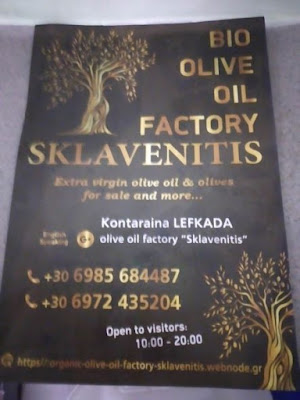The olive trees on my land have been there for centuries and it was no easy task harvesting for the first time. I took the advice of when to harvest from Greek neighbours, local to my land, as each producers geographical area, altitude and type of olive is different.
My olive grove is in a mountain valley, south facing, terraced land. The trees had been planted strategically on the edge of each stone wall terrace so that wheat could be grown between the trees, maximising the use of the land.
Traditionally blacks nets are placed on the ground below the trees to catch the falling olives when harvesting. I used tarpaulins as I found the leaves and twigs get stuck in the nets and they tend to snag on the uneven ground. Because of the positioning of the trees, tarpaulins have to be laid on both levels, the lane side trees being the most difficult.
The trees are then beaten with a long wooden stick to release the olives. This is an ancestral technique which has been used for centuries. The idea is to strike the olives from the tree with minimal trauma by not breaking the trees limbs. Nowadays you can purchase a long metal pole with a plastic rake attached, also machines are used to shake the trees of their olives.
If the tops of the trees cannot be reached 'a climber' is sent into the tree to strike it from above. This is also an opportunity to prune a tree with a chainsaw, so that the following years growth is of a more manageable height to harvest and so that the tree has room to grow healthier, producing a better crop.
When the olives have fallen they are sifted by hand to remove as many twigs and leaves as possible before scooping them into sacks. Plastic crates can be used as they are better, allowing for the olive to aerate, but this is more expensive and takes up more storage.
My elderly neighbour told us that years ago the men beat the trees and the women, on their hands and knees, would scoop up the fallen olives directly from the ground (no nets) into their aprons and deposit them into hessian sacks.
Olive harvesting is back breaking, physically hard labour. Yet you can still see elderly villagers well into their seventies harvesting by the traditional method.
But there is always time for a Greek coffee break. In the past I have helped harvest and experienced a wonderful community spirit, with a group picnic lunch in the olive grove.
It is imperative that the olives are taken to be processed as soon as they have been harvested, as the olive will start to spoil. Our chosen factory was Sklavenitis Bio Olive Oil Factory, Kontaraina, Lefkada.
I telephoned ahead of our visit and was given an estimated time slot, but when I arrived the factory was full with customers waiting to process their respective olives. I decided to return later in the evening.Sacks and crates of olives were stacked high arriving on various vehicles and trailers, some even coming from the island of Meganisi by ferry.
First the olives are loaded into a giant hopper and then shaken onto a rising conveyer belt separating olives from the leaves and twigs, which are discarded.
The olives are then washed and weighed.
The olives enter a machine that grinds them to a pulp with added water and rotates for 45 minutes. The water temperature is 28 degrees which is the perfect temperature for extracting more oil from the olive. Unfortunately this method has been proven to affect the quality and flavour of extra virgin olive oil.
The elephant machine (you can clearly see why it is called that) then extracts the water separating it from the oil.
This machine is the warmest area in the factory and on the coldest night of the year so far (4 degrees) the resident cats and kittens took refuge.
At this factory the pulp waste is collected in 750 kg silo containers and sent to another factory to be processed again into vegetable oil for cooking.
Next, the oil enters two filtering systems and as it passes through, the oil is calculated in litres.
The lusciously green olive oil (pure gold) spills from this into a stainless steel container. When the last of our oil was processed (and blessed by the overhanging icon) it was pumped into our respective containers.
Whist waiting for our olives to be processed I met some wonderful Greek landowners with stories to tell, helped others empty their olives into the hopper and loaded trucks with containers full of olive oil.
We shared local red wine and sampled bread soaked in cups of delicious olive oil. A truly unique and fascinating evening out.



.jpg)




































Comments
Post a Comment